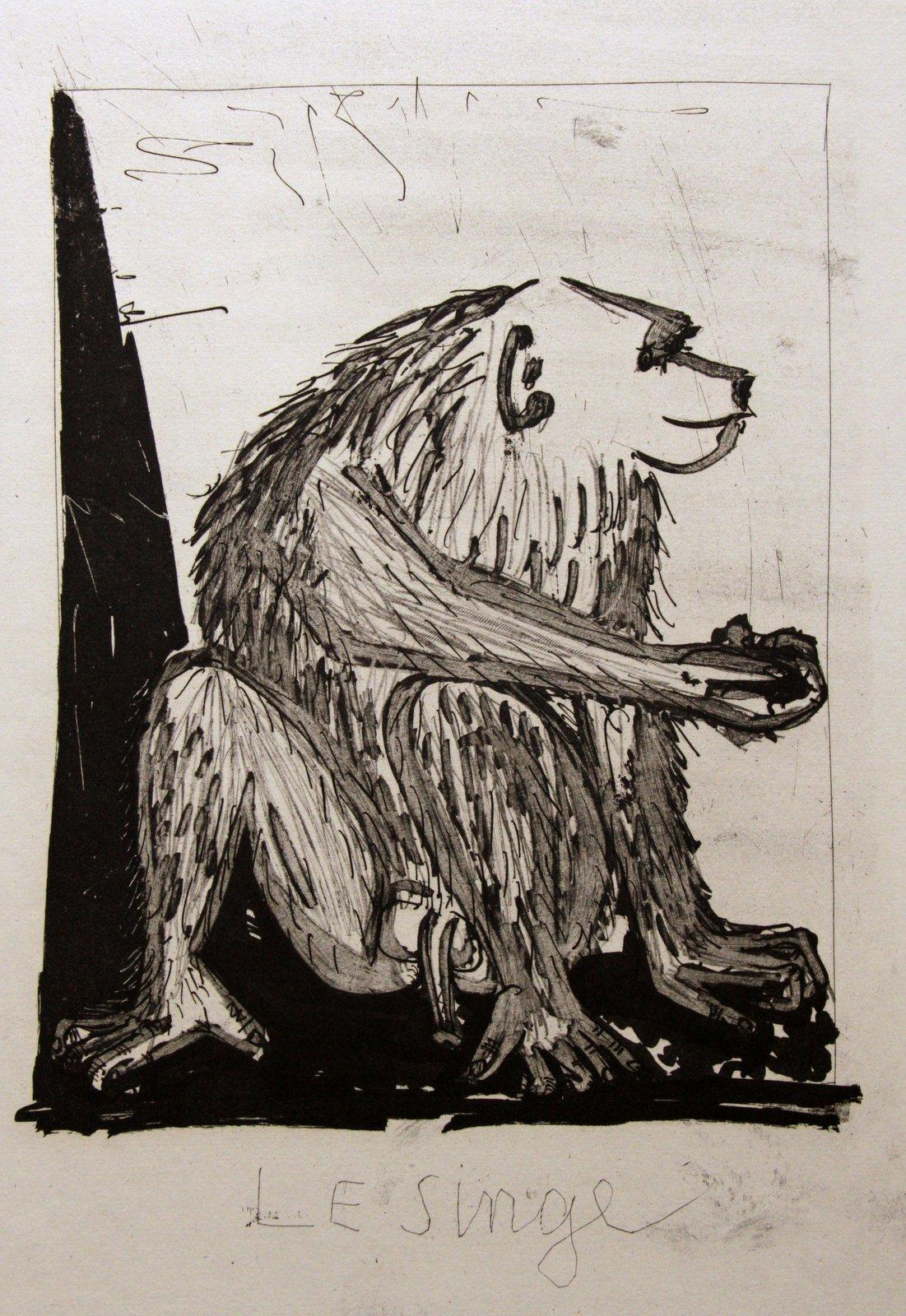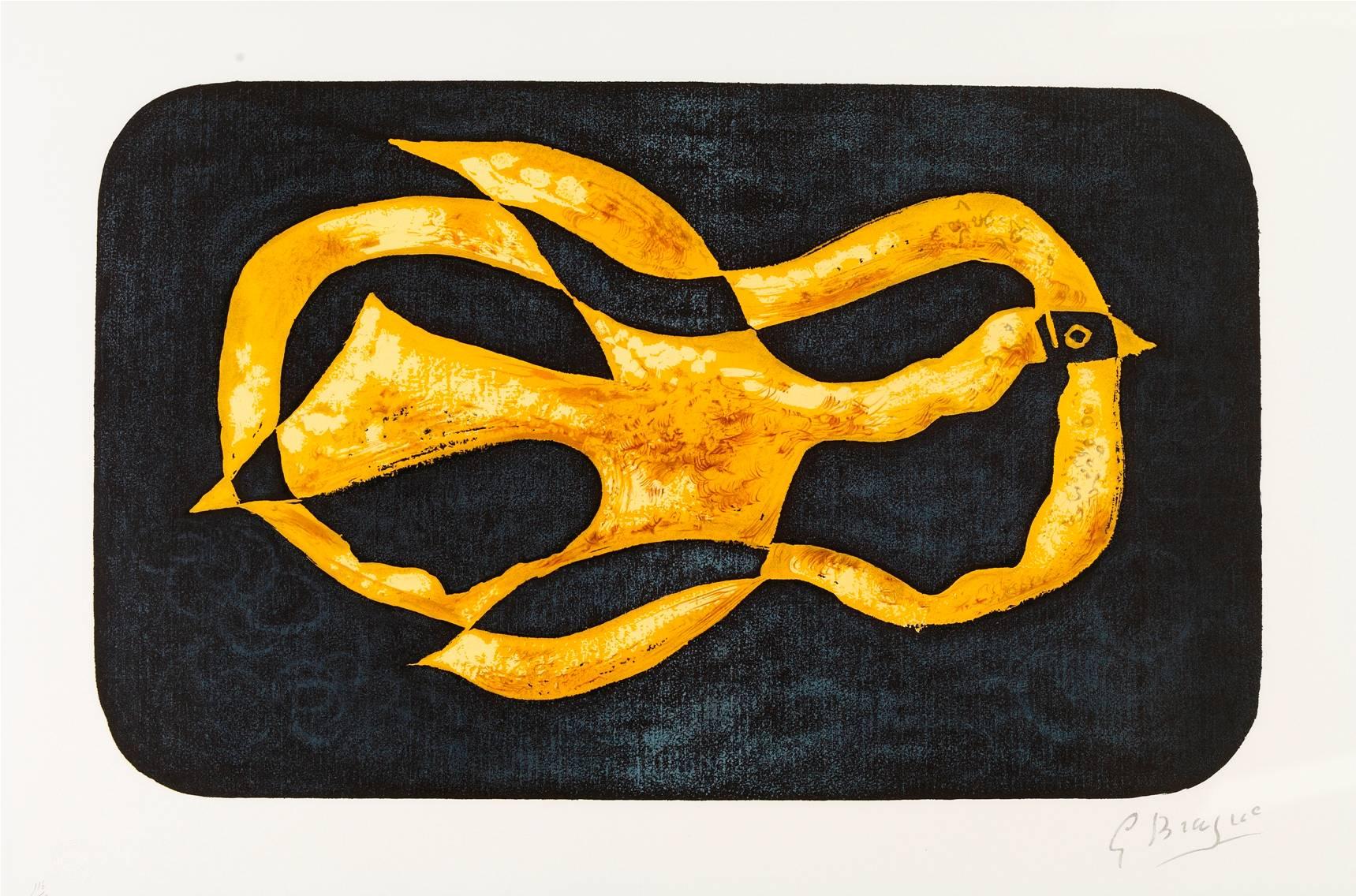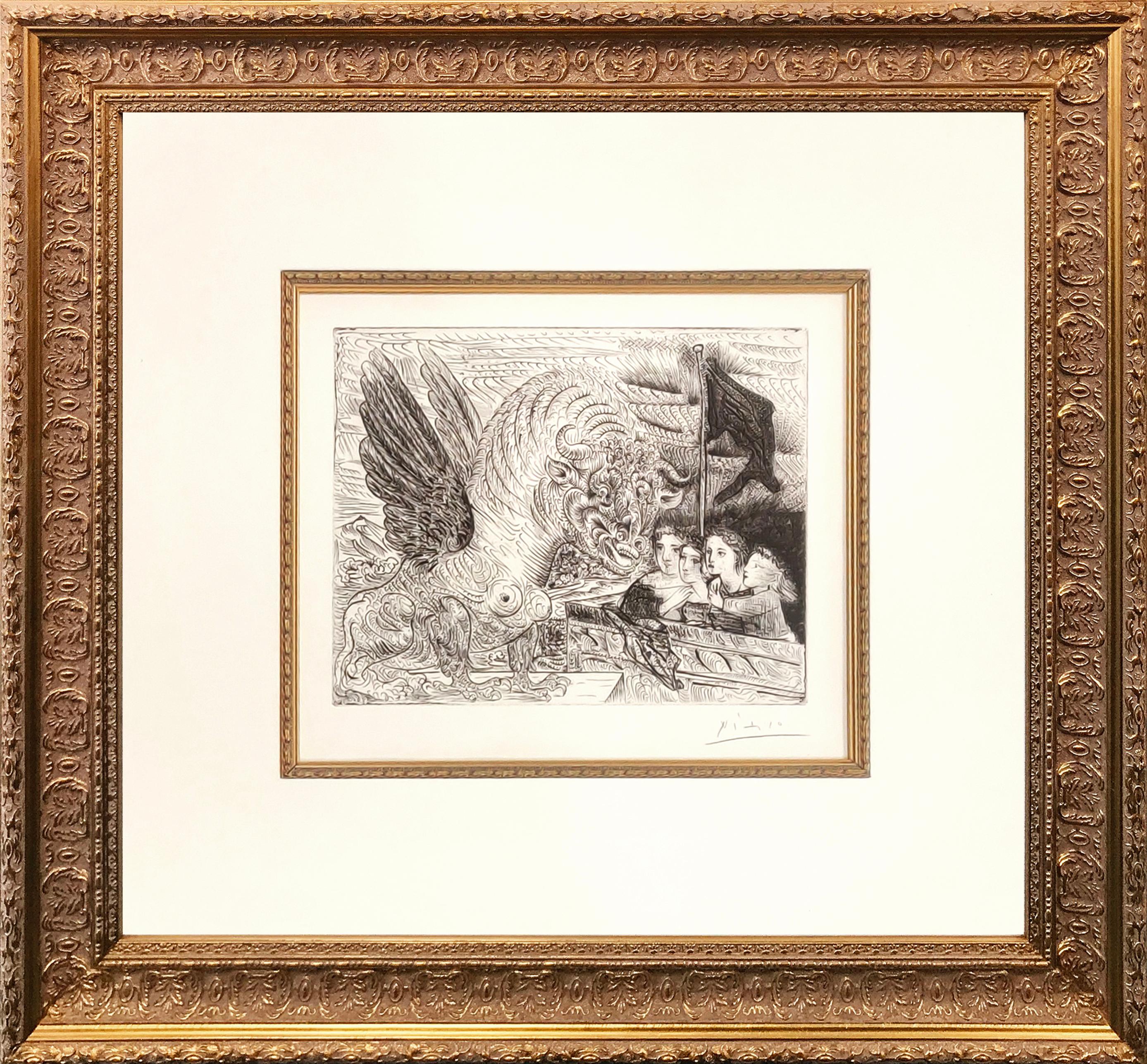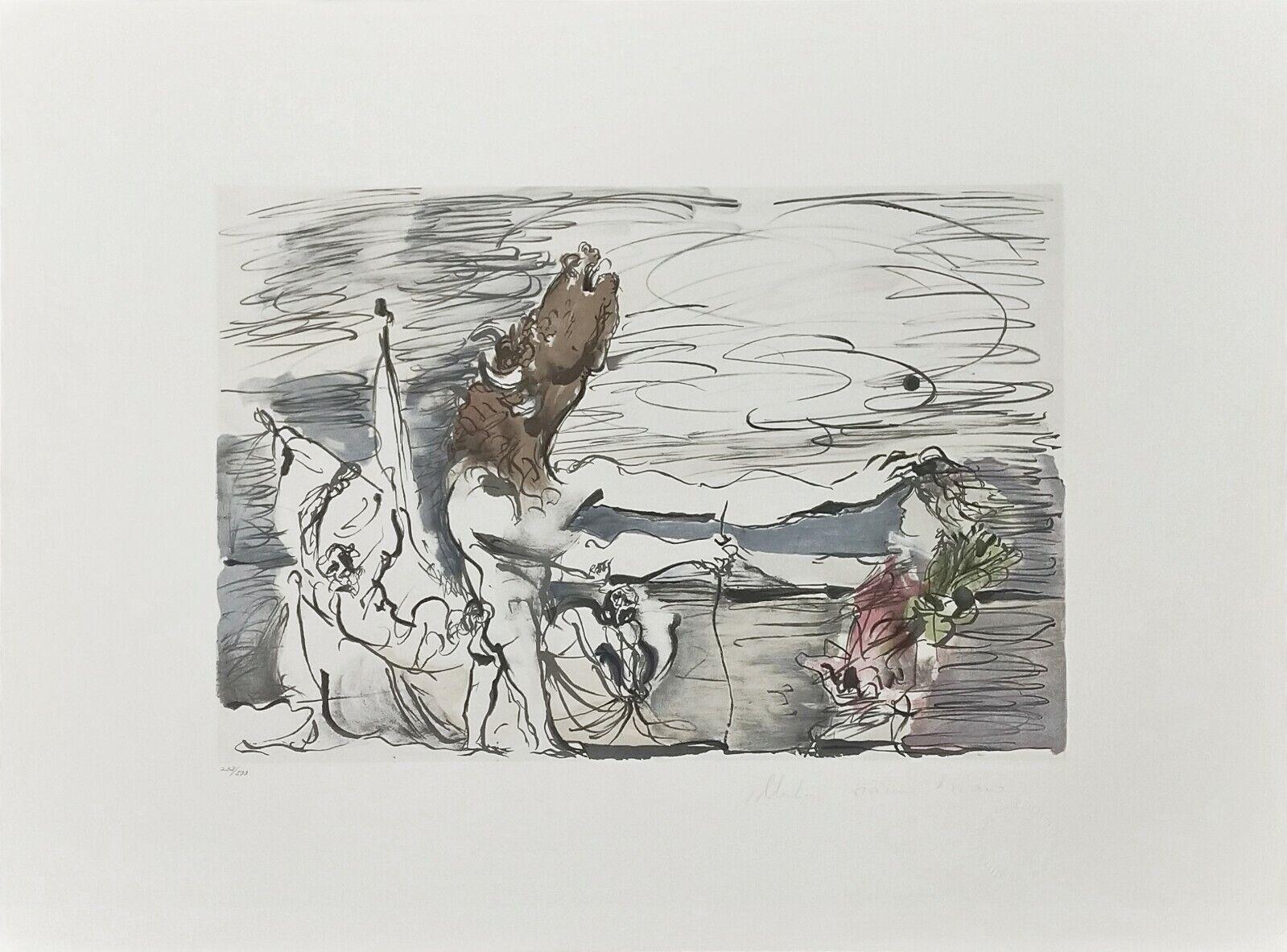Items Similar to Migration - Etching by Georges Braque - 1962
Want more images or videos?
Request additional images or videos from the seller
1 of 8
Georges BraqueMigration - Etching by Georges Braque - 19621962
1962
About the Item
" Migration " is an etching realized by Georges Braque in 1962. The print is hand signed and numbered. This is an edition of 90 prints.
Bibliography: D. Vallier, Braque : l'oeuvre gravé: catalogue raisonné , Flammarion, Paris 1982, p.241, n.72.
Georges Braque (1882-1963) was a French Fauve painter who began to rethink his own painting style after admiring Picasso’s Les Demoiselles . Using the painting’s revolutionary elements as a point of departure, together Braque and Picasso invented Cubism around 1908 in the belief the art of painting had to move far beyond the depiction of visual reality. Most scholars call the first phase of Cubism, developed cooperatively by Picasso and Braque, Analytic Cubism, because essentially it is a painterly study of the structure of form.
- Creator:Georges Braque (1882 - 1963, French)
- Creation Year:1962
- Dimensions:Height: 18.9 in (48 cm)Width: 14.77 in (37.5 cm)Depth: 0.04 in (1 mm)
- Medium:
- Movement & Style:
- Period:
- Framing:Framing Options Available
- Condition:Insurance may be requested by customers as additional service, contact us for more information.
- Gallery Location:Roma, IT
- Reference Number:
About the Seller
4.9
Platinum Seller
These expertly vetted sellers are 1stDibs' most experienced sellers and are rated highest by our customers.
1stDibs seller since 2017
6,739 sales on 1stDibs
Typical response time: 2 hours
- ShippingRetrieving quote...Ships From: Grasse, France
- Return PolicyA return for this item may be initiated within 14 days of delivery.
More From This SellerView All
- Le Singe - Etching by Pablo Picasso - 1940sBy Pablo PicassoLocated in Roma, ITNot Signed. Not Numbered. Edition of 225 pieces. Etching - aquatint. Belongs to the Suite "Histoire Naturelle de Buffon". Catalogue Bloch n.339. Passepartout included.Category
1940s Cubist Figurative Prints
MaterialsEtching, Paper
- Crow - Etching by Leo Guida - 1970sBy Leo GuidaLocated in Roma, ITCrow is an Etching realized by Leo Guida in the 1970s on cardboard. Good condition. Artist sensitive to current issues, artistic movements and historical techniques, Leo Guida has ...Category
1970s Contemporary Figurative Prints
MaterialsEtching
- Dark Lemur - Etching by Leo Guida - 1972By Leo GuidaLocated in Roma, ITDark Lemur is an Etching realized by Leo Guida in 1972s. Good condition, Hand signed, dated with pencil. Artist sensitive to current issues, artistic movements and historical techn...Category
1970s Contemporary Figurative Prints
MaterialsEtching
- The Raven and the Fox - Etching - 1974By Salvador DalíLocated in Roma, ITThe Raven and the Fox is an artwork realized in 1974. Etching and drypoint with stencil, 1974. Printed by Atelier Rigal. Edition XIV/CXX on Auvergne paper. It belongs to the sui...Category
1970s Surrealist Figurative Prints
MaterialsEtching
- The Horse and the Wolf - Etching - 1974By Salvador DalíLocated in Roma, ITThe Horse and the Wolf is an artwork realized in 1974. Etching and drypoint with stencil. Printed by Atelier Rigal. Edition XIV/CXX on Auvergne paper. It belongs to the suite Le ...Category
1970s Surrealist Figurative Prints
MaterialsEtching
- Plague-Stricken Animals - Etching - 1974By Salvador DalíLocated in Roma, ITPlague-Stricken Animals is an artwork realized in 1974. Etching and drypoint with stencil. Dimensions: 59 x 79 cm. Printed by Atelier Rigal. Edition XIV/CXX on Auvergne paper. I...Category
1970s Surrealist Figurative Prints
MaterialsEtching
You May Also Like
- PEINTRE AU TRAVAIL (BLOCH 1157)By Pablo PicassoLocated in Aventura, FLEtching, aquatint, drypoint and scraper, on Rives BFK paper. Hand signed and numbered by Pablo Picasso. Published by Galerie Louise Leiris, Paris. Image size 12.125 x 18.125 inches. ...Category
1930s Cubist Animal Prints
MaterialsDrypoint, Paper, Aquatint, Engraving
- After Georges Braque - Antiborée - LithographLocated in Collonge Bellerive, Geneve, CHLithograph after Georges Braque. Signed in the plate Edition of 150 Dimensions: 76 x 117 cm Bibliography: « Les Métamorphoses de Braque» of Heger de Loewenfeld and Raphaël de Cuttoli , Editions FAC, Paris, 1989. In 1961 Georges Braque decided with his laidary friend Heger de Loewenfeld to pick up certain of his works to in order to create artworks, this beautiful litograph is one of them. Héméra in the Mythology: In Greek mythology Hemera was the personification of day and one of the Greek primordial deities. She is the goddess of the daytime and, according to Hesiod, the daughter of Erebus and Nyx (the goddess of night). Hemera is remarked upon in Cicero's De Natura Deorum, where it is logically determined that Dies (Hemera) must be a god, if Uranus is a god. The poet Bacchylides states that Nyx and Chronos are the parents, but Hyginus in his preface to the Fabulae mentions Chaos as the mother/father and Nyx as her sister. She was the female counterpart of her brother and consort, Aether (Light), but neither of them figured actively in myth or cult. Hyginus lists their children as Uranus, Gaia, and Thalassa (the primordial sea goddess), while Hesiod only lists Thalassa as their child. The father of Cubism Three Cubist that distinguishes art historian periods were initiated and developed by Georges Braque: The Cubist Cézanne (1907-1909), Executive (1909-1912) and synthetic (1912-1922). Post-Impressionist and fawn, Braque no longer adheres to the contingency of a decorative way or the other. Cézanne’s paintings exhibited at the Grand Palais during the retrospective of 1907 are a revelation: Cézanne sought and invented a pictorial language. In his footsteps, Braque went to the South with the reasons of the Master. He returned with Estaque landscapes and surprising Ciotat it keeps Cezanne geometric model and retains the “passages” continuity from one surface to another to create the sensation of “turning around” of the object represented. But he wants to go after the consequences of the vision of Cezanne. In his paintings Houses in L’Estaque (1908) it simplifies the volumes of houses, neglects detail by removing doors and windows: the plastic rhythm that builds the table. Large Nude , a masterpiece of the period, can be considered the first work of Cézanne cubism . Systematizing and deepening Braque discoveries open the door analytical cubism. In 1909, his painting became more cerebral than sensual. The pattern is recreated in the two-dimensionality of the canvas, leaving aside any illusionistic perspective. In Still Life with Violin, objects are analyzed facets according to their characteristic elements, each facet referring to a particular view of the object. There are so many facets of points selected view: Table reflects the knowledge of the object and the ubiquity of the eye. Moreover, Braque is looking for the essence of the objects in the world rather than their contingency, which explains the absence of light source and use of muted colors (gray, ocher), contingent aspects of the object . But formal logic has stepped facets, erased any anecdote to the object and ultimately led to his painting a hermetic more marked on the edge of abstraction (see the series of Castle Roche-Guyon ). Braque, anxious to keep the concrete and refusing at all costs that the logic of Cubism takes the paintings to abstract, reintroduced signs of reality in his paintings in 1912 marks the beginning of Synthetic Cubism. Historians speak of “signs of real” rather than reality because what interests Braque, this is not to put reality into a table, but to create a painting which, by its language, refers to the real. To do this, he invented two major techniques XX th century inclusions and contributions. The inclusions consist of painting objects that have no real depth, materials (wallpaper in Nature morte aux playing cards faux wood is a pictorial inclusion) or letters (calligraphic inclusion in Portuguese ), made first brush and a few months later stencil. Contributions are defined in contrast with the collage on canvas of foreign materials: glued or sand paper, sawdust, etc.. Regarding the collages, Braque used for the first time in September 1912 a piece of adhesive paper imitating faux wood Compote...Category
1950s Cubist Animal Prints
MaterialsLithograph
- La Fille aux OiesBy Jean-Emile LaboureurLocated in New York, NYJean-Emile Laboureur (1877-1943), La Fille aux Oies, engraving, 1916, signed in pencil lower left, numbered (4/40) lower right and inscribed “imp,” also titled lower left margin edge...Category
1910s Cubist Figurative Prints
MaterialsEngraving
- TAUREAU AILE CONTEMPLE PAR QUATRE ENFANTS (BLOCH 229)By Pablo PicassoLocated in Aventura, FLPlate 13 from La Suite Vollard. Bloch 229. Baer 444. Etching on Montval paper. Signed in pencil, from the edition of 260 (there was also an edition of 50 with larger margins). Printe...Category
1930s Cubist Animal Prints
MaterialsPaper, Engraving
- MINOTAURE AVEUGLE CONDUIT PAR UNE PETITE FILLEBy (after) Pablo PicassoLocated in Aventura, FLSelected from the personal collection inherited by Marina Picasso, Pablo Picasso's granddaughter. After Pablo Picasso's death, his granddaughter Marina authorized the printing of t...Category
1980s Cubist Animal Prints
MaterialsLithograph, Paper
- NATURE MORTE A LA PALETTE ET A LA TETEBy (after) Pablo PicassoLocated in Aventura, FLSelected from the personal collection inherited by Marina Picasso, Pablo Picasso's granddaughter. After Pablo Picasso's death, his granddaughter Marina authorized the printing of t...Category
1980s Cubist Animal Prints
MaterialsLithograph, Paper
Recently Viewed
View AllMore Ways To Browse
F R Pratt
Andoe Horse
Jack Coughlin Art
Warhol Ram
Bw Bunny
Campfire Marshmallows
Carousel Horse 1981
Cecil Aldin Stage Coach
Colombe Volant
Cyril Powers
Dali Blue Owl
David Hockney Little Boodge
Ding Darling
Dominique Denou
Evert Louis van Muyden On Sale
Forest Spotted Owlet
George Rodrigue Framed Limited Edition
Giovanni Fattori On Sale



